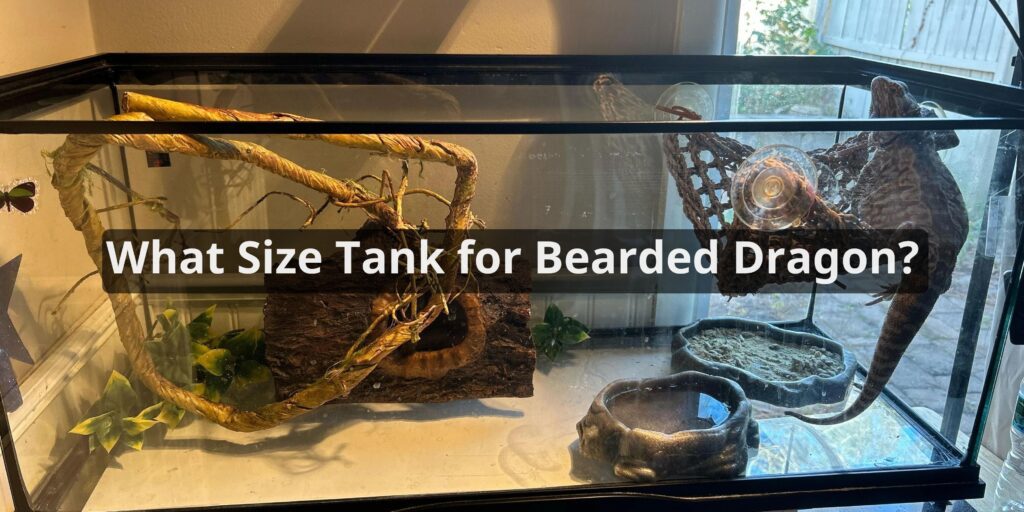Deciding on the right size tank for a bearded dragon is an important part of preparing to bring home your new reptile friend. While they may seem small when young, bearded dragons grow quickly and can reach up to 24 inches as adults. Selecting an appropriately sized habitat right from the start will save you from having to upgrade later on. In this article, we’ll explore what size tank for bearded dragon at different life stages.
Baby & Juvenile Bearded Dragons

A baby bearded dragon is quite small, usually 4 to 6 inches long when first brought home. A juvenile reaches 6 to 12 inches. At these young ages, a 20 gallon long tank is sufficient. This provides enough room for a basking area on one end, with a cooler retreat on the other. It’s important that baby dragons have room to find heat or get away from it as needed. Proper temperature gradients are crucial for their health.
The 20 gallon tank size should be adequate for the first 3 to 6 months of a bearded dragon’s life. During this rapid growth phase, you’ll need to upgrade eventually. As your dragon gets bigger, a larger tank will be required. Aim to upgrade by the time your beardie reaches 12 inches long.
Adult Bearded Dragon Tank Size
An adult bearded dragon can measure 18 to 24 inches nose to tail tip. This calls for a minimum tank size of 40 gallons, though bigger is always better. A 40 gallon “breeder” style tank that is longer than it is tall is recommended. This gives your fully grown dragon ample floor space to move around and climb.
A 4′ x 2′ x 2′ (120 gallon) tank is ideal for most adult bearded dragons. This provides room for a basking shelf, hiding spots, and an excellent temperature gradient from one end to the other. Some owners opt for even larger custom built enclosures, around 6′ long. This allows for more exercise and enrichment.
Keep in mind that bearded dragons continue growing up to 18 months old. So while that 40 gallon tank is the minimum, consider going bigger if possible right from the start. This eliminates the need to upgrade tanks multiple times as your dragon grows. An adult sized tank will simply provide more room for your dragon to thrive.
Other Tank Size Considerations
When deciding what size tank to get, also factor in the number of accessories needed inside. Your bearded dragon’s habitat should contain:
- Basking area with overhead heat lamp
- UVB lighting
- Hiding places like caves or hammocks
- Climbing branches and decor
- Food and water dishes
- Substrate or reptile carpet
All of these items take up space in the tank. Make sure to allow for furnishings when determining what size to purchase. A tank that seems big enough might end up feeling cramped once decorated and occupied.
Additionally, if housing more than one bearded dragon together, get a much larger enclosure. Dragons may fight or bully tankmates if space is limited. A 6 foot long tank is recommended for a pair or small group of dragons. Provide multiple basking shelves, hides, food stations and sight barriers. This allows each lizard their own territory and minimizes aggression issues.
Conclusion
Providing an adequately sized tank is one of the most important factors in keeping a bearded dragon healthy and happy in captivity. Allow at least 20 gallons for a baby, 40 gallons for an adult minimum, and ideally a 4 foot or longer tank as they grow. Make sure to also factor in space needed for accessories and enrichment items. With the right size tank and proper setup, your bearded dragon will thrive in its home environment.
FAQs About What Size Tank for Bearded Dragon
Can I use a glass or plastic tank, or are there specific tank types recommended for bearded dragons?
Glass and plastic tanks both work, but glass is more common. Ensure proper ventilation and escape-proof closures, regardless of the material.
How important is vertical space in a bearded dragon tank compared to horizontal space?
Horizontal space is more critical than vertical. Bearded dragons are terrestrial, so they need more floor space for movement, but some vertical elements for climbing are beneficial.
What are the pros and cons of using a custom-built enclosure versus a commercially available tank?
Custom-built enclosures allow more flexibility in size and design but can be costly and time-consuming. Commercial tanks are convenient but may have size limitations.
Are there specific dimensions I should consider when choosing a tank for my bearded dragon?
Choose a tank with dimensions that allow for a basking area, hiding spots, and space for food and water dishes. The tank should be longer horizontally rather than tall.
How does the tank size affect the overall well-being and comfort of a bearded dragon?
Adequate tank size promotes physical and mental well-being. It allows for natural behaviors, better temperature gradients, and reduces stress, contributing to a healthier, happier dragon.
Are there any rules of thumb for tank size adjustments as a bearded dragon grows or ages?
As a bearded dragon grows, upgrade their tank size accordingly. Young dragons can start in smaller tanks, but plan to transition to larger enclosures as they reach adulthood.



